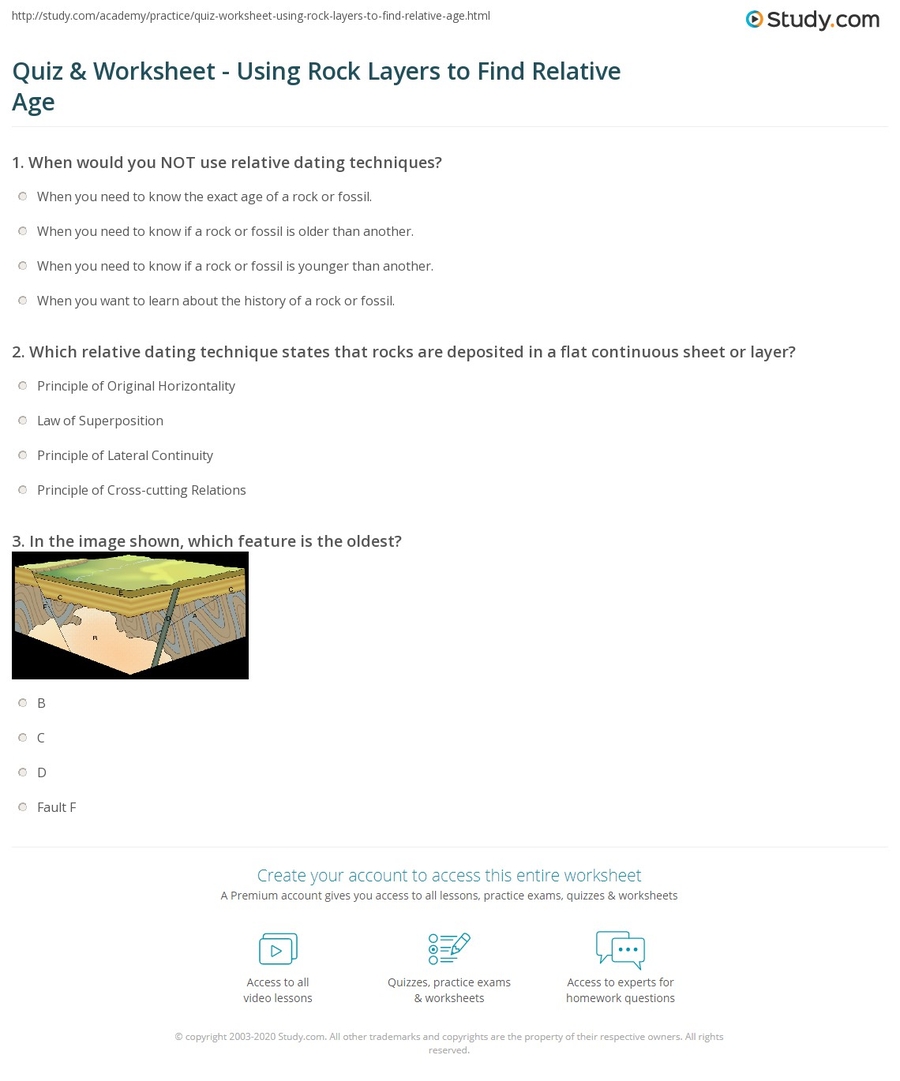Relative dating of rocks
Dating > Relative dating of rocks
Click here: ※ Relative dating of rocks ※ ♥ Relative dating of rocks
For example, techniques based on isotopes with half lives in the thousands of years, such as Carbon-14, cannot be used to date materials that have ages on the order of billions of years, as the detectable amounts of the radioactive atoms and their decayed daughter isotopes will be too small to measure within the uncertainty of the instruments. Carbon-14, the radioactive isotope of carbon used in carbon dating has a half-life of 5730 years, so it decays too fast. For example, a key bed from around the time that the dinosaurs went extinct is very important. In geology, when an intrusion cuts across a formation of , it can be determined that the igneous intrusion is younger than the sedimentary rock.

It meant there was enough time for life to evolve gradually. On a larger scale, even between continents, fossil evidence can help in correlating rock layers. Prior to the discovery of in the early 20th century, which provided a means ofand north relative dating to of materials. Only lived for a specific period of time 2. But what if rock layers are far apart. Since the rock formation contains both types of fossils the ago of the rock formation must be in the overlapping date range of 415 to 420 idea years. Often, the sedimentary basin is within rocks that are very different from the sediments that are being deposited, in which the lateral limits of the sedimentary layer will be marked by an abrupt change in rock type.
The early geologic time scale could only show the order of events. Geologists still use the following principles today as a means to provide information about geologic history and the timing of geologic events. Sedimentary rocks in particular are notoriously radioactive-free zones.

Dating Fossils – How Are Fossils Dated? - Which rock in the photo below formed first, the igneous rock A or the sedimentary rock B? Relative age dating also means paying attention to crosscutting relationships.

So, how do we know how old a fossil is? There are two main methods determining a age, relative dating and absolute dating. Relative dating is used to determine a fossils approximate age by comparing it to similar rocks and fossils of known ages. Absolute dating is used to determine a precise age of a fossil by using radiometric dating to measure the decay of isotopes, either within the fossil or more often the rocks associated with it. The majority of the time fossils are dated using relative dating techniques. Using relative dating the fossil is compared to something for which an age is already known. For example if you have a and it was found in the Wheeler Formation. The Wheeler Formation has been previously dated to approximately 507 million year old, so we know the trilobite is also about 507 million years old. Scientists can use certain types of fossils referred to as to assist in relative dating via correlation. Index fossils are fossils that are known to only occur within a very specific age range. Typically commonly occurring fossils that had a widespread geographic distribution such as brachiopods, trilobites, and ammonites work best as index fossils. If the fossil you are trying to date occurs alongside one of these index fossils, then the fossil you are dating must fall into the age range of the index fossil. Sometimes multiple index fossils can be used. In a hypothetical example, a rock formation contains fossils of a type of brachiopod known to occur between 410 and 420 million years. The same rock formation also contains a type of trilobite that was known to live 415 to 425 million years ago. Since the rock formation contains both types of fossils the ago of the rock formation must be in the overlapping date range of 415 to 420 million years. Studying the layers of rock or strata can also be useful. Layers of rock are deposited sequentially. If a layer of rock containing the fossil is higher up in the sequence that another layer, you know that layer must be younger in age. This can often be complicated by the fact that geological forces can cause faulting and tilting of rocks. Absolute dating is used to determine a precise age of a rock or fossil through methods. This uses radioactive minerals that occur in rocks and fossils almost like a geological clock. So, often layers of volcanic rocks above and below the layers containing fossils can be dated to provide a date range for the fossil containing rocks. The atoms in some chemical elements have different forms, called isotopes. These isotopes break down at a constant rate over time through radioactive decay. By measuring the ratio of the amount of the original parent isotope to the amount of the daughter isotopes that it breaks down into an age can be determined. We define the rate of this radioactive decay in half-lives. If a radioactive isotope is said to have a half-life of 5,000 years that means after 5,000 years exactly half of it will have decayed from the parent isotope into the daughter isotopes. Then after another 5,000 years half of the remaining parent isotope will have decayed. While people are most familiar with carbon dating, carbon dating is rarely applicable to fossils. Carbon-14, the radioactive isotope of carbon used in carbon dating has a half-life of 5730 years, so it decays too fast. It can only be used to date fossils younger than about 75,000 years. Potassium-40 on the other hand has a half like of 1. This makes it ideal for dating much older rocks and fossils.
Last updated